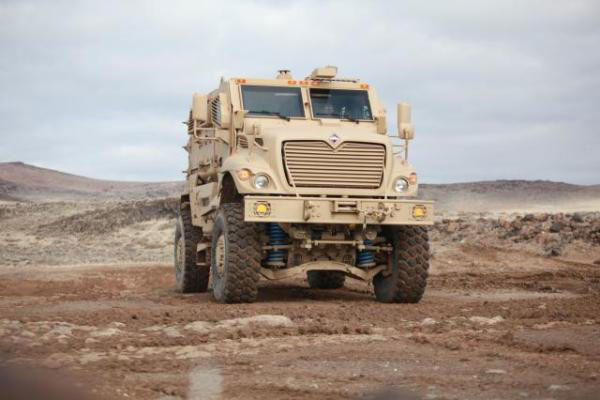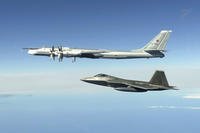Navistar Defense is trying to convince the U.S. Army to use the latest version of its heavily-armored MRAP vehicle as a replacement for Vietnam War-era fleet of M113 troop carriers.
The new MaxxPro Mine Resistant Ambush Protected vehicle features a beefed-up suspension and a more powerful engine -- upgrades that make the armored chariot capable of keeping up with the Army's front-line fleet of M1 tanks and Bradley fighting vehicles, Navistar officials said.
And the price might be just right, since the Army already paid for 2,200 of these upgraded MRAPs. The Army awarded Navistar with a 2012 contract worth about $880 million for 2,700 improved chassis packages.
Navistar's pitch comes less than two weeks before the deadline for defense companies to submit proposals for the Army's AMPV solicitation. AMPV became the Army's top vehicle modernization effort after the service killed its high-profile Ground Combat Vehicle program earlier this year.
GCV's demise came when Congress cut $492 million -- 83 percent -- of the program's funding for fiscal 2015. The ambitious program was the latest victim of budget challenges created by the automatic, across-the-board reductions under sequestration.
But defense experts have said that the Army's failed attempt at replacing the M2 Bradley fighting vehicle is not unlike the service's past attempts to replace its arsenal of Cold-War technology.
The question now is whether the effort to replace the M113 armored personnel carrier will meet the same fate as the GCV and other canceled programs such as the XM2001 Crusader self-propelled howitzer, the RAH-66 Comanche scout helicopter, and the Manned Ground Vehicles family under the Future Combat Systems program.
Army officials took delivery of 2,200 of these new MRAPs -- a purchase worth $490 million -- and used them to upgrade 580 MaxxPros into essentially brand-new vehicles. Then the Army terminated the contract in July 2013 after the service chose to place most of its MRAP vehicles into storage.
Navistar officials want the Army to relax its tracked-based requirement for its Armored Multi-Purpose Vehicle and considering a mixed fleet, including wheeled vehicles, to replace the boxy, obsolete M113s.
"The Army spent a lot of money on this platform, and it has proven itself to be very successful," said John Akalaonu, senior program manager at Navistar Defense. "The [improvised explosive device] threat is not going away; let's look and see what we can do with this. Let's look and see if we can provide a bridging strategy to AMPV."
But Navistar Defense isn't the only company trying to convince the Army to examine existing vehicles to help replace the M113 fleet.
General Dynamics Land Systems, the maker of the Stryker family of wheeled combat vehicles, maintains that the AMPV requirements are "stacked up to not allow an open competition and force you to deliver a Bradley solution," said Pete Keating, spokesman for GDLS, who described the discussions GDLS is having with the Army.
As an alternative, GDLS has pitched the idea of a mixed fleet that includes Stryker medical vehicles.
The platform was already tested in a non-Stryker unit when the Army outfitted the 3rd Infantry Division units in 2010 with Stryker medical evacuation vehicles for a tour in Iraq, Keating said.
"We said ‘look you have already invested in those vehicles and you know from combat experience that the medical evacuation Stryker is much, much better than a tracked vehicle,'" he said. "It's much better than a Bradley; it's a smoother ride. It's quicker; if you can't get a helicopter you don't want to put a wounded guy in a tracked vehicle and rattle him all the way to the hospital."
In addition, the Stryker double V hull provides twice the protection of the AMPV requirement, Keating said.
The Army would prefer a Bradley-based solution, and has tried to make it a fair process by offering excess Bradley chassis -- made by BAE Systems -- to competing firms to use in the competition, Keating said.
"OK, so I take these Bradleys, which I am getting at the right quantity and the right time, and in six months pass a design review that certifies with all the technical data and all the testing that you have not changed the Bradley to a degree that it will not meet the performance specs today," Keating said.
"We don't have all that data. We obviously wouldn't have BAE proprietary data, but we also don't have all the Army test data on the Bradley."
With proposals for the AMPV solicitation due May 28, GDLS has "no options off the table, including going to federal court and mounting a protest," Keating said.
GDLS officials also said that using Stryker medical evacuation vehicles would save the Army about $2 billion compared to a Bradley-only solution in life cycle costs.
"These have already been tested and approved… so you get them about two years earlier because with the AMPV -- whatever the solution is -- that vehicle goes into development it has to go through the test regime," Keating said.
BAE Systems officials said they are satisfied with the competition so far.
Army officials "did a pretty good job on this program of developing a set of requirements that define a vehicle that meets their requirements for this multipurpose vehicle in an armored brigade combat team," said Mark Signorelli, vice president and general manager for Combat Vehicles at BAE Systems.
"There are other vehicles that can fill a role, but they don't meet the performance requirements to operate in the environment where an armored brigade combat team operates."
Navistar officials, however, maintain that the Army has no idea if these upgraded MaxxPros will work until they are tested against AMPV requirements, Akalaonu said.
"These vehicles were never tested," he said. "[The Army] never did testing with the new suspensions to test it with new AMPV requirements."
The Army has made up its mind that it wants a tracked AMPV for units at the brigade level and below, Akalaonu said. But for units above brigade level that are not in the close fight "we think that the MaxxPro plays a role," Akalaonu said.
"You won't hear me say our solution is one hundred percent," he said. "Let's do some testing to look at it for alternative uses."
-- Matthew Cox can be reached at Matthew.Cox@monster.com.






























